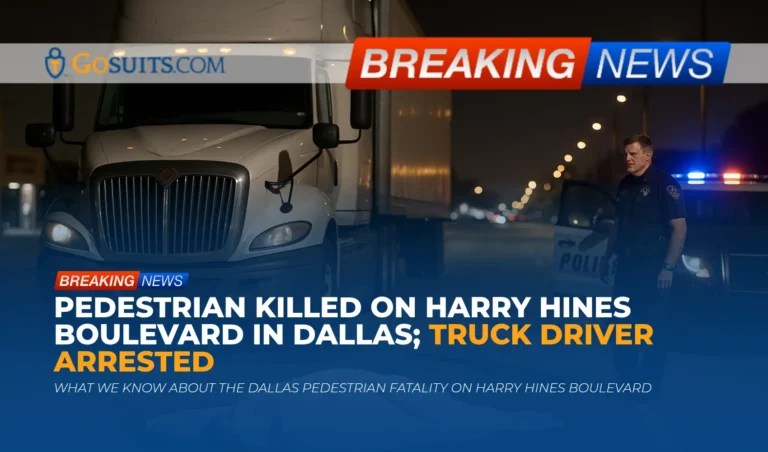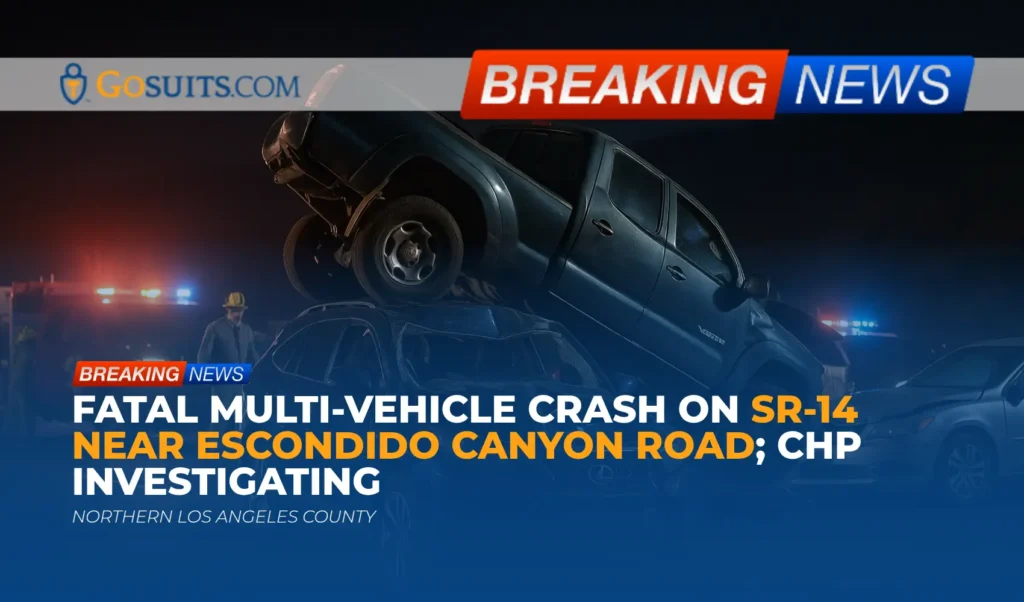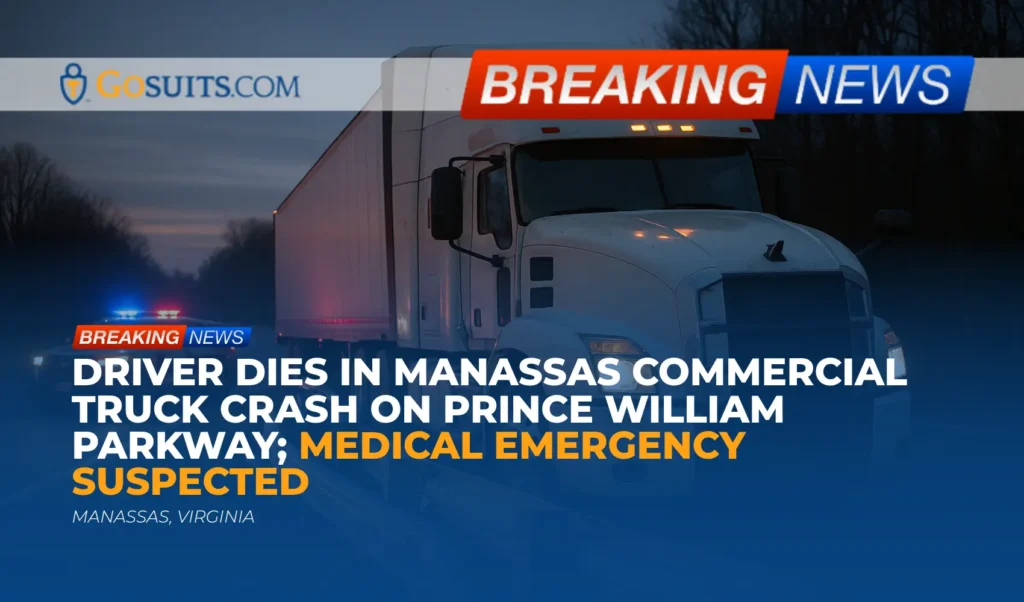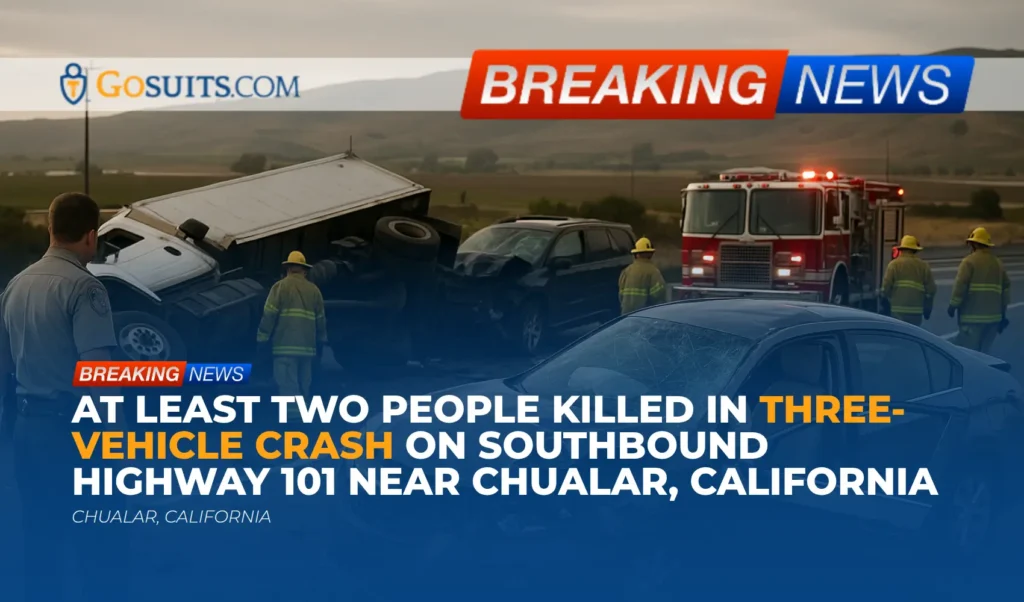- What We Know About the Dallas Pedestrian Fatality on Harry Hines Boulevard
- What Remains Unknown at This Time
- Supportive First Steps Families Commonly Take After a Fatal Crash
- Official Records: How to Obtain Police Reports, Autopsy Findings, and Death Certificates
- Texas Pedestrian and Driver Duties: Key Laws That Often Matter
- Potential Civil Liability in Pedestrian Fatalities
- Insurance Issues That Frequently Arise
- Evidence Preservation Checklist After a Serious Crash
- Timelines and Statutes of Limitations in Texas
- Wrongful Death and Survival Claims in Texas: What They Can Cover
- Safety Context for Overnight Pedestrian Crashes
- Practical Resources and Agencies That Can Help
- Commentary from Gosuits Dallas, Texas Personal Injury Attorney
- Why Taking Action Matters Now
- Sources
What We Know About the Dallas Pedestrian Fatality on Harry Hines Boulevard
According to information released by Dallas police through local media reports, a pedestrian was struck by a truck in the 5200 block of Harry Hines Boulevard in Dallas during the early morning hours. The collision occurred shortly after 3:30 a.m. on a Saturday. Police indicated the truck’s driver lost control and hit the pedestrian. The pedestrian was transported to a nearby hospital and later died from their injuries. The driver of the truck was arrested.
At this stage, these details highlight a sudden and devastating event: a late-night crash involving a truck and a person on foot in a busy commercial corridor. Families reading this may be processing shock and grief while trying to understand next steps. The information below is intended to clarify typical processes, point to public records that may exist, and outline civil-law considerations that often arise in fatal pedestrian cases in Texas.
What Remains Unknown at This Time
Publicly reported information does not yet include the names of the pedestrian or the driver, and no detailed account of how or why the driver reportedly lost control has been released. It is also not yet clear whether any contributing factors, such as excessive speed, distraction, impairment, road surface conditions, lighting, or vehicle defects, played a role. These kinds of specifics are typically clarified later through ongoing police investigation, crash reconstruction, vehicle examinations, and official reports.
Supportive First Steps Families Commonly Take After a Fatal Crash
In the aftermath of a sudden loss, families often need both emotional support and practical information. The steps below reflect common approaches people use to find answers and preserve important rights; they are general informational suggestions rather than directives.
- Identify the investigating agency and obtain the crash report number. For incidents within city limits, local police usually lead the on-scene investigation. Ask for the Dallas police report number, the assigned investigator’s name, and the vehicle unit handling the case.
- Locate and preserve all paperwork from the hospital and first responders. Hospital intake documents, transport records, and any property return forms can be important later.
- Document what witnesses tell you. If anyone shares what they saw, write down their names, contact information, and a summary of their account while memories are still fresh.
- Preserve personal devices and accounts. Keep the decedent’s phone, smartwatch, and cloud logins secured; location and activity data might assist in reconstructing events.
- Consider grief support resources. The moments and weeks after a sudden loss are overwhelming. National and local resources exist to help families process grief and trauma.
- Before speaking with insurance carriers, consider consulting a seasoned attorney first. Insurance adjusters may request recorded statements very early. What is said can be used later in ways that are hard to anticipate.
Official Records: How to Obtain Police Reports, Autopsy Findings, and Death Certificates
Crash Reports
In Texas, official crash reports are maintained at the state level. Eligible requestors can typically purchase the report online after it is filed by the investigating agency. The Texas Department of Transportation explains the process for requesting crash reports here: Texas Department of Transportation (search for “crash report” information on their site). These reports usually include the date, time, location, vehicles involved, narrative summaries, contributing factors as noted by the investigating officer, and diagram(s).
When requesting, it is helpful to have:
- Exact location: 5200 block of Harry Hines Boulevard, Dallas
- Date/time: Shortly after 3:30 a.m., Saturday
- Investigating agency: Dallas Police Department
- Case or report number: If available from the officer or records unit
Autopsy and Medical Examiner Records
In Dallas County, medical examiner services are performed through the county’s medical examiner’s office. Next of kin can generally request copies of the autopsy report once it becomes available. The timeline may vary depending on pending studies (for example, toxicology). Families often receive preliminary information sooner and complete reports later.
While local websites may explain the request process, a state-level overview of vital records and related processes is available from the Texas Department of State Health Services. For general guidance on death records, see the state portal: Texas DSHS Vital Statistics – Death Records.
Death Certificates
Death certificates are maintained at the state and local level in Texas. Certified copies may be needed for probate, life insurance, and other administrative matters. Information about obtaining Texas death records is available at the Texas Department of State Health Services: DSHS Vital Statistics – Death Records.
911 Audio, Dispatch Logs, and Body-Worn Camera Footage
These materials may exist and can be important in understanding timing, scene conditions, and early statements. Requests for such records are generally made through public information channels under Texas law. The Texas Attorney General provides statewide open-records guidance for requestors on its .gov site: Texas Attorney General – Open Government. Agencies may withhold some information based on legal exemptions while an investigation is active, but families can often begin the request process early.
Texas Pedestrian and Driver Duties: Key Laws That Often Matter
Texas law imposes duties on both drivers and pedestrians. In serious and fatal collisions, investigators and insurers frequently analyze these statutes alongside physical evidence and witness accounts.
- Driver’s duty to exercise due care: Texas Transportation Code requires drivers to exercise due care to avoid colliding with pedestrians and to take proper precautions when necessary. See Transportation Code § 552.008.
- Yielding and crossing rules: Right-of-way rules, crosswalk obligations, and crossing outside intersections are addressed in Chapter 552 of the Transportation Code. See Chapter 552.
- Negligence framework: Even when a pedestrian is outside a marked crosswalk, a driver can still be civilly liable if they failed to use ordinary care, including safe speeds for conditions or proper lookout.
These statutes are only part of the analysis. Crash reconstruction, lighting and visibility, road design, vehicle maintenance, and potential driver fatigue or distraction can all factor into how liability is assessed in a civil claim.
Potential Civil Liability in Pedestrian Fatalities
Without speculating about facts not yet released in the Dallas case, the following civil-law pathways commonly apply in Texas fatal pedestrian crashes:
- Driver negligence: Claims generally assert the driver failed to use ordinary care, such as maintaining proper control, traveling at a safe speed for conditions, keeping a proper lookout, or taking reasonable evasive action. The “lost control” description reported by police often triggers a closer look at speed, distraction, fatigue, sudden mechanical issues, and road surface conditions.
- Employer liability (if a work vehicle): If the truck was being operated in the course and scope of employment, the employer can sometimes be vicariously liable for the driver’s negligence under traditional agency principles. Direct negligence claims (for example, negligent entrustment, hiring, or supervision) can also arise depending on the facts.
- Vehicle maintenance or defect issues: If control was lost due to mechanical failures, tire problems, or other defects, claims may explore maintenance providers or, in rare cases, product defect theories, guided by engineering evidence.
- Roadway design and lighting: In limited circumstances, evidence may show unusual hazards related to road design or lighting. Claims involving governmental entities have special notice rules and immunities. These are fact-intensive and time-sensitive matters.
For grieving families, it is often important to have investigators retrieve electronic data, interview witnesses quickly, and secure any available video because these materials can clarify whether the event was preventable and who should be held financially responsible under Texas civil law.
Insurance Issues That Frequently Arise
Vehicle crashes generally involve several layers of potential coverage. Each layer can impact the path forward after a fatality:
- Liability coverage of the at-fault driver: This is typically the first source of payment for wrongful death claims. Policy limits vary widely and can be insufficient in fatal cases.
- Commercial auto coverage: If the truck was used for work or belonged to a company, one or more commercial policies may apply. Policies can include higher limits, multiple layers, or umbrella coverage.
- Uninsured/Underinsured Motorist (UM/UIM): If the at-fault coverage is insufficient or disputed, UM/UIM on a household policy may respond. UM/UIM procedures are technical and deadline-sensitive.
- Personal Injury Protection (PIP) or medical payments: These first-party benefits may help with certain expenses, regardless of fault, depending on the policy.
- Life insurance and accidental death benefits: Separate from auto insurance, these benefits may be available to beneficiaries and commonly require certified death certificates and claims forms.
Insurance companies often request early statements and authorizations. Before engaging in detailed conversations with any insurer, consider speaking with an attorney to understand rights and potential pitfalls; recorded statements and broad medical authorizations can have lasting consequences.
Evidence Preservation Checklist After a Serious Crash
Key evidence can be lost quickly after a night-time roadway fatality. The following items are commonly pursued by families and their legal representatives to ensure a complete picture of what occurred:
- Police crash report and supplements: The initial report may be followed by supplemental narratives or reconstructions. Keep track of updates.
- Body-worn and dash camera footage: Early public information requests may help secure video before retention periods expire.
- Private and public video sources: Corridor businesses, transit vehicles, rideshares, nearby residences, and traffic cameras may hold helpful footage. Preservation letters should be sent quickly to prevent overwriting.
- Vehicle electronic data: Modern vehicles often store speed, brake, and throttle data. Commercial trucks may capture detailed event and telematics information. Prompt preservation demands are crucial.
- Driver phone and app data: Call logs, text activity, navigation apps, and work apps can corroborate timelines or distraction. Preserving this data often requires legal process.
- Scene documentation: Skid marks, debris fields, resting positions, and lighting conditions change quickly. Photographs, measurements, and return visits to the site help.
- Medical records and autopsy: These records explain the cause and mechanism of death and may align timing and physics of the crash with injuries sustained.
- Witness statements and contact info: Independent witnesses can be pivotal in resolving disputes about speed, signals, and driver behavior.
Timelines and Statutes of Limitations in Texas
Texas places time limits on filing civil claims. Missing a deadline can permanently end the ability to seek compensation in court. While unique exceptions exist, families should be aware of the default timelines:
- General two-year limitations period: Most wrongful death and personal injury claims must be filed within two years. See Texas Civil Practice and Remedies Code § 16.003.
- Government claims notice: When a governmental entity might be involved, additional formal notice requirements and shorter deadlines can apply. This is very fact-specific.
Because the clock can begin running quickly and evidence may be lost within days or weeks, many families choose to get legal guidance early.

Wrongful Death and Survival Claims in Texas: What They Can Cover
Texas law provides two principal civil-law avenues after a fatal incident:
- Wrongful Death claim: Brought by certain statutory beneficiaries (generally the spouse, children, and parents), focusing on their losses arising from the death. See Texas Civil Practice and Remedies Code Chapter 71.
- Survival action: Brought by the decedent’s estate to recover damages the person could have pursued had they survived, such as conscious pain and suffering, medical expenses before passing, and property damage. See § 71.021.
Depending on the evidence, recoverable damages may include loss of financial support, loss of companionship and guidance, mental anguish of beneficiaries, funeral and burial expenses, pre-death medical costs, and other categories recognized by Texas law. Every case is fact-specific; the law looks at the circumstances, relationships, and measurable as well as human losses that follow a preventable death.
Safety Context for Overnight Pedestrian Crashes
Nighttime pedestrian crashes present unique hazards: reduced visibility, glare from headlights, fewer active witnesses, and, at times, higher operating speeds on wide arterials. Even when sidewalks or crossings exist, people on foot can be difficult for inattentive drivers to detect. National and state transportation safety agencies consistently emphasize that drivers should reduce speed, maintain diligent lookout, and use extreme caution when visibility is limited. See general pedestrian-safety resources from the National Highway Traffic Safety Administration at NHTSA – Pedestrian Safety.
In civil cases, the question is not only where the pedestrian was, but whether the driver used ordinary care given the conditions. That includes adjusting speed, avoiding distraction, ensuring headlights are functioning, and reacting appropriately to hazards that should be anticipated on a corridor known for mixed traffic and foot traffic, especially during late-night hours.
Practical Resources and Agencies That Can Help
Dallas Police Department
The Dallas Police Department investigates crashes within city limits. Families often request the incident or case number, the assigned investigator’s name, and the unit handling the crash. Follow-up inquiries can be made to the records or vehicle/crash investigation unit. While the statewide crash report is usually obtained through TxDOT, Dallas Police can provide status updates about the investigation and may inform families when the state crash report becomes available.
Texas Department of Transportation (TxDOT) – Crash Reports
TxDOT facilitates the purchase of official crash reports for eligible parties. Visit the agency’s website for instructions: Texas Department of Transportation and search for “Crash Reports.”
Medical Examiner’s Office
In Dallas County, autopsies are performed through the county medical examiner. Next of kin can request autopsy reports once finalized. If a funeral home is involved, it can often help coordinate necessary paperwork and timing. For a state-level overview of death records processes, see DSHS Vital Statistics – Death Records.
Death Certificates
Certified death certificates are typically obtained through local registrars or the Texas Department of State Health Services. Information about eligibility, fees, and processing times can be found at DSHS Vital Statistics.
Open Records and Public Information
Some records such as 911 audio, dispatch logs, or body-worn camera video may be requested under Texas public information laws. The Texas Attorney General provides guidance for requestors and agencies here: Texas Attorney General – Open Government. Keep in mind that active investigations may restrict immediate release of some materials.
Emotional Support
Traumatic loss affects each person differently. Many communities lean on counselors, faith leaders, and peer support groups. National resources include the 988 Suicide and Crisis Lifeline (dial 988) for immediate support and the Substance Abuse and Mental Health Services Administration at samhsa.gov for mental health and grief resources.
Commentary from Gosuits Dallas, Texas Personal Injury Attorney
We extend our sincere condolences to everyone affected by the fatal pedestrian crash on Harry Hines Boulevard. Losing a loved one suddenly and without warning is life-altering. This article is intended for general information and education during a very difficult time.
From a civil-law standpoint, the limited facts publicly shared raise important questions commonly explored in pedestrian fatality cases: how speed, visibility, and driver attention intersected; whether the driver took reasonable steps to maintain control; and whether any mechanical or roadway factors contributed. When police indicate a driver “lost control,” a thorough civil investigation typically examines potential causes with objective data and independent analysis.
Insurance carriers and corporations often move quickly after serious incidents. Adjusters may ask for recorded statements, medical authorizations, or signatures on forms that seem routine. It is not unusual for these requests to be framed as helpful, but they can narrow or undermine civil claims later. Power imbalances are most acute in the first days and weeks after a tragedy, when families are grieving and unfamiliar with dense insurance terms, exclusions, and procedural traps. Having a skilled advocate explain rights, evidence needs, and timing requirements can level the playing field.
An early, no-cost consultation can help clarify the process, preserve key evidence, and avoid missteps with insurers. Even a short conversation focused on rights, documents to gather, and preservation steps can make a meaningful difference as the investigation unfolds.

Why Taking Action Matters Now
The window to protect civil rights after a serious crash is shorter than many realize. Evidence is perishable and deadlines are strict. Acting promptly tends to improve clarity, reduce disputes, and safeguard the ability to hold the proper parties financially responsible under Texas law.
- Secure time-sensitive evidence. Video from nearby businesses, rideshares, and transit vehicles is often overwritten within days. Vehicle electronic data can be lost if a car or truck is put back into service or repaired. Preservation letters should be delivered without delay.
- Avoid insurance pitfalls. Early statements to insurers can be taken out of context. Before communicating with any carrier, consider a free consultation to understand what to share and when. Statements and authorizations can affect future claims.
- Understand the civil timeline. Texas generally applies a two-year limitations period to wrongful death and personal injury claims, with special notice rules when public entities may be involved. Starting early helps ensure compliance.
- Coordinate official records. Crash reports, autopsy findings, and death certificates each serve a distinct purpose. Gathering them methodically helps align facts, timelines, and causation analyses.
- Reduce family burdens. Organizing paperwork, expenses, and benefits claims early makes the months ahead more manageable and allows families to focus on healing.
Next practical steps commonly include: identifying the investigating officer and case number, preserving potential video sources, requesting the state crash report through TxDOT when available, and consulting with a seasoned attorney prior to speaking with any insurer. What is said to an insurance company can be used in ways that are not obvious at the time.
Suggested Next Steps
- Document and preserve: Collect photos, witness contacts, and any personal device data. Keep all hospital and responder paperwork.
- Request official records: Obtain the TxDOT crash report when available; track medical examiner and death certificate status.
- Consult before insurer contact: Speak with a qualified attorney first; understand rights and risks before giving statements.
- Send preservation notices: Consider formal letters to involved parties to secure vehicle EDR data and potential video.
- Respect timelines: Calendar important dates to avoid missing statutory deadlines.
Get a Free Case Review Preserve Evidence Checklist Understand Your Rights
Sources
- Texas Transportation Code § 552.008 (Drivers to Exercise Due Care)
- Texas Transportation Code, Chapter 552 (Pedestrians)
- Texas Civil Practice and Remedies Code § 16.003 (Limitations Period)
- Texas Civil Practice and Remedies Code § 71.002 (Wrongful Death)
- Texas Civil Practice and Remedies Code § 71.021 (Survival)
- Texas Department of Transportation – Crash Report Information
- National Highway Traffic Safety Administration – Pedestrian Safety
- Texas Department of State Health Services – Death Records
- Texas Attorney General – Open Government (Public Information)






